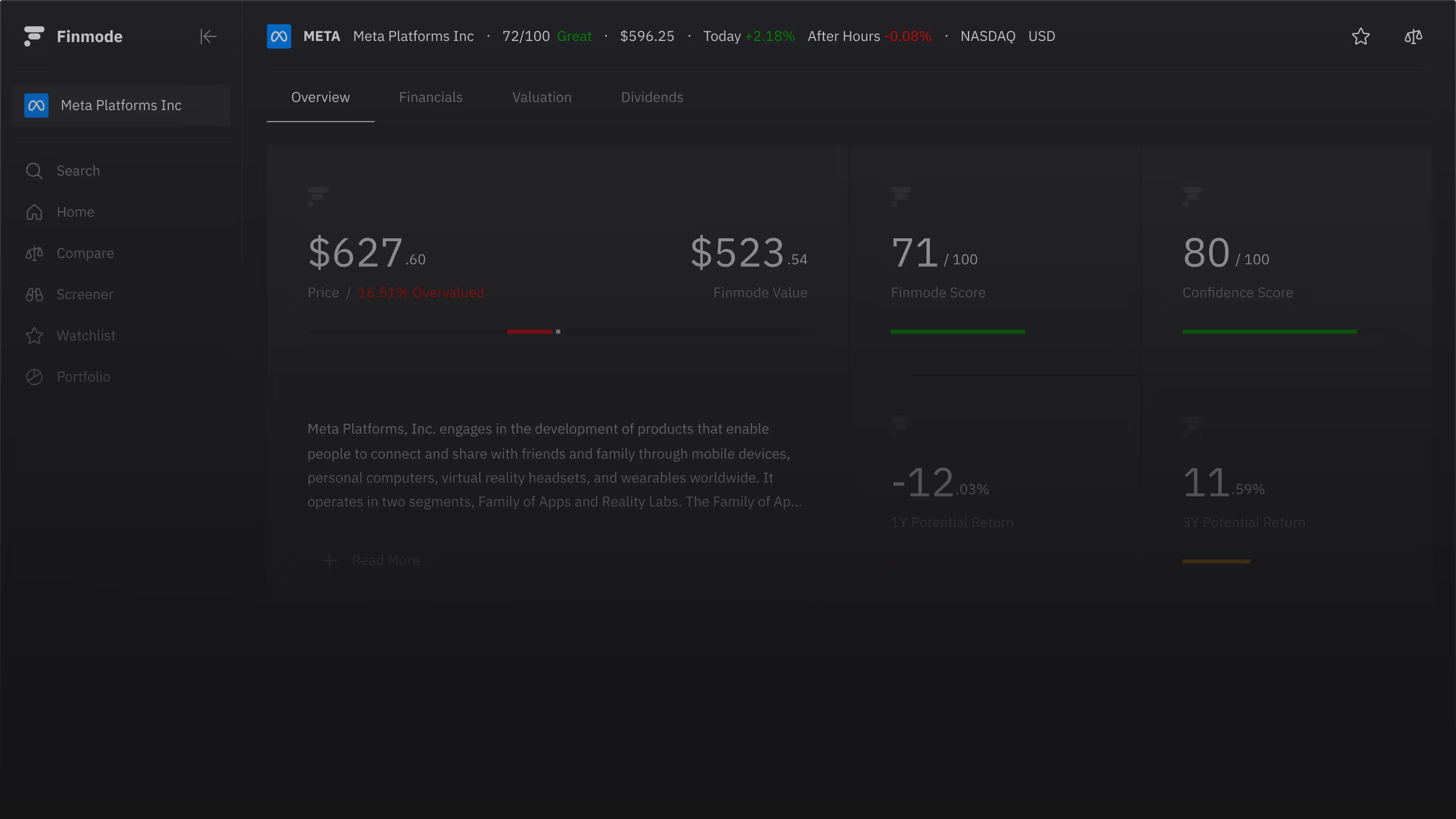The DCF Model: A Step-by-Step Guide to Calculating Intrinsic Value

Quick Answer: How a DCF Model Works
A DCF model operates on a simple principle: a dollar tomorrow is worth less than a dollar today. The model projects a company's future Free Cash Flow (FCF) for a set period (e.g., 5-10 years), then "discounts" those future cash flows back to their present-day value using a discount rate (WACC). It adds a "terminal value" (representing all cash flows after the forecast period) and sums it all up to arrive at a single number: the company's intrinsic value.
What is a Discounted Cash Flow (DCF) Model?
At its core, a DCF model is a calculation that determines what a company is worth by estimating the total value of all its future cash flows.
Think of it this way: when you buy a stock, you are buying a partial ownership stake in a business. What you are really buying is a claim on that business's future earnings. A DCF analysis is simply the process of forecasting those future earnings and translating them into a single, concrete number you can use today.
If your calculated DCF value is higher than the current stock price, the stock may be undervalued. If it's lower, the stock may be overvalued. This gap between value and price is the foundation of value investing.
Why the DCF Model is a Value Investor's North Star
Many valuation metrics - like the Price-to-Earnings (P/E) or Price-to-Book (P/B) ratios - are relative. They tell you how a stock is priced compared to its peers or compared to its own history.
A DCF model is different. It's an absolute valuation method.
It doesn't care what the "market" thinks or how other similar stocks are trading. It forces you to think like a business owner, not a stock trader. You must answer the fundamental questions:
- How much cash will this business generate?
- How sustainable is that cash generation?
- What are the risks to those future cash flows?
This process, while difficult, aligns perfectly with the philosophy of investors like Warren Buffett. You are focused on the business's underlying economic moat and its long-term cash-generating power, not on short-term market noise.
The 3 Core Components of a DCF Valuation
Before we build the model, you need to understand its three main ingredients. Every DCF analysis, from a simple spreadsheet to a complex institutional model, is built on these pillars.
- Future Free Cash Flow (FCF): This is the cash a company generates after accounting for the capital expenditures needed to maintain or expand its asset base. It's the "free" cash available to be returned to all investors (both debt and equity holders).
- Discount Rate (WACC): This is the rate of return required to compensate investors for the risk of holding the asset. A higher risk means a higher discount rate, which in turn means a lower present value. We typically use the Weighted Average Cost of Capital (WACC).
- Terminal Value (TV): You can't forecast cash flows forever. The terminal value is a simplified calculation that represents the value of the company's cash flows for all years beyond the explicit forecast period (e.g., years 6 through infinity).
A 5-Step Guide to Building Your DCF Model
This is the practical, step-by-step process. We will build a "Unlevered DCF," which values the entire enterprise (both debt and equity) and is the most common method.
Step 1: Forecast Future Free Cash Flow (FCF)
Your first task is to project the company's Free Cash Flow to the Firm (FCFF) for the next 5 or 10 years.
FCFF Formula:
EBIT (Earnings Before Interest & Taxes) * (1 - Tax Rate) + Depreciation & Amortization - Capital Expenditures (CapEx) - Change in Net Working Capital
You'll find these line items in a company's financial statements.
- EBIT, D&A: Income Statement
- CapEx: Cash Flow Statement
- Working Capital: Balance Sheet (Current Assets - Current Liabilities)
How to Project: You can't just guess. Base your projections on historical performance and management's guidance.
- Revenue Growth: Start by forecasting revenue growth. Is it a 15% growth company or a 3% utility?
- Profitability: Assume operating margins (EBIT) will stay consistent, or "revert to the mean" unless there's a clear competitive advantage.
- CapEx & Working Capital: Project these as a percentage of revenue, based on historical averages.
This is the most "art" part of the "science." A 2% change in your growth assumption can have a massive impact, so be conservative.
Step 2: Calculate the Discount Rate (WACC)
Next, you need the "discount rate" to pull those future cash flows back to the present. We use the Weighted Average Cost of Capital (WACC).
WACC represents the blended, average rate of return a company must pay to all its investors (both debt and equity).
WACC Formula (Simplified): WACC = (Weight of Equity * Cost of Equity) + (Weight of Debt * Cost of Debt) * (1 - Tax Rate)
- Weight of Equity: Market Cap / (Market Cap + Total Debt)
- Cost of Equity: Often calculated using the Capital Asset Pricing Model (CAPM). This is the "risk-free rate" (like a 10-yr Treasury bond) + (Beta * Equity Risk Premium).
- Weight of Debt: Total Debt / (Market Cap + Total Debt)
- Cost of Debt: The effective interest rate the company pays on its debt.
A high WACC (e.g., 12%) implies a risky company, while a low WACC (e.g., 7%) implies a very stable, safe company.
Step 3: Determine the Terminal Value (TV)
You've forecasted FCF for years 1-5, but the company will (hopefully) keep earning money long after that. The Terminal Value (TV) captures the value of all cash flows from Year 6 to infinity.
We use the Gordon Growth Model (or Perpetuity Growth Model) for this.
Terminal Value Formula: TV = (Final Year's FCF * (1 + Perpetual Growth Rate)) / (WACC - Perpetual Growth Rate)
- Final Year's FCF: This is the FCF you projected for Year 5 (or Year 10).
- Perpetual Growth Rate (g): This is the rate you expect the company to grow at forever. This rate must be low. It should be less than or equal to the long-term rate of global GDP growth (e.g., 2.0% - 3.0%). Using a high number here (like 5%) will destroy your valuation.
Step 4: Discount All Cash Flows to Present Value (PV)
Now, you just do the math. You take each of your projected FCF values (Years 1-5) and your Terminal Value (which "sits" in Year 5) and discount them back to today using your WACC.
Present Value Formula: PV = FCF / (1 + WACC)^n (where 'n' is the year number)
Example Calculation:
- PV of Year 1 FCF = FCF_Year1 / (1 + WACC)^1
- PV of Year 2 FCF = FCF_Year2 / (1 + WACC)^2
- ...
- PV of Year 5 FCF = FCF_Year5 / (1 + WACC)^5
- PV of Terminal Value = TV / (1 + WACC)^5
Step 5: Calculate Intrinsic Value & Margin of Safety
You're at the finish line.
- Calculate Enterprise Value (EV): Sum up all your Present Values (PV) from Step 4. EV = (PV of FCF Year 1) + (PV of FCF Year 2) ... + (PV of FCF Year 5) + (PV of Terminal Value)
- Calculate Equity Value: The Enterprise Value is what the whole company is worth. To find the value for shareholders, you must subtract net debt. Equity Value = Enterprise Value - Net Debt (Net Debt = Total Debt - Cash & Equivalents)
- Calculate Intrinsic Value Per Share: Intrinsic Value Per Share = Equity Value / Total Shares Outstanding
This final number is your DCF valuation. You can now compare this to the current stock price. The difference between your calculated value and the market price is your Margin of Safety.
The "Hard Way" vs. The "Finmode Way"
As you can see, building a DCF model from scratch is a complex, time-consuming process.
- You have to manually pull dozens of data points from 10-K filings.
- You must research and defend every assumption, from revenue growth to Beta.
- A single formula error in your spreadsheet can throw off your entire valuation.
This is the "hard way." It's an essential skill, but it's a bottleneck for investors who need to analyze dozens of companies.
Platforms like Finmode are designed to automate this entire process. We aggregate the financial data, run standardized DCF models in seconds, and present the key assumptions clearly. This allows you to move from calculation to analysis. You can spend your time testing assumptions (What if growth is only 3%?) instead of building spreadsheets.
Common DCF Pitfalls (And How to Avoid Them)
A DCF is a powerful tool, but it's sensitive. Be aware of these common traps.
- Trap 1: The "Garbage In, Garbage Out" Problem. Your valuation is only as good as your assumptions. Overly optimistic growth or margin forecasts will lead to a high, unrealistic intrinsic value.
- Solution: Be conservative. Use historical averages and analyst consensus as a baseline. Run multiple scenarios (Base, Best, and Worst Case).
- Trap 2: The Terminal Value is Too High. The Terminal Value often accounts for 60-80% of the total DCF value. Using a high perpetual growth rate (e.g., 4%+) is the most common mistake and will artificially inflate your valuation.
- Solution: Cap your perpetual growth rate at the long-term inflation or GDP growth rate (2.0-3.0%).
- Trap 3: Ignoring the Balance Sheet. A company with a mountain of debt or underfunded pension liabilities may look cheap on a DCF, but the risk is hidden.
- Solution: Always complete Step 5. Subtracting Net Debt to get from Enterprise Value to Equity Value is non-negotiable.
A DCF is a Tool, Not an Oracle
A Discounted Cash Flow model doesn't give you "the" answer. It gives you an answer based on a set of assumptions.
No single metric should ever be your sole reason for buying a stock. Use your DCF calculation as one part of a comprehensive financial analysis. Compare it to relative valuation metrics (P/E, P/B) and, most importantly, a qualitative assessment of the business's management, industry, and competitive advantages.
A DCF is a tool for thinking. Use it to understand what the market is "pricing in" and to test your own thesis about a company's future.
Frequently Asked Questions FAQ
Read more insights
Intrinsic Value Calculation: A Step-by-Step Guide for 2025
Margin of Safety: The Value Investor's Ultimate Protection
Try Finmode Today
Free To Get Started

